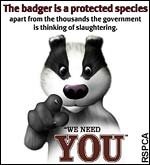Rumours circulated in February, and early March we understand that many staff were offered cash in lieu of notice. Over 100 operatives are involved, many with up to 20 years experience of field work with badgers, and considerable expertise in the habits of sick ones. How to recognise a vibrant and healthy sett etc. (Or even - we kid you not - how to recognise a badger sett, and not confuse it with rabbit holes or a fox's earth - many of which were happily mapped by Chris Cheeseman's rosy cheeked graduates in the early days of Krebs. Well it was a 'hole' - what did you expect? But the down side of their reigned in exuberance was that we had 3 single hole 'hospital setts' which were completely missed by the mappers, and their very sick occupants left to wreak their havoc for several years.)
"The cost of sacking the wildlife officers, some of whom have been with the department for more than 20 years, has been put at between £2 million and £3 million and is covered in a story by the Western Morning News "
The redundancies have been attacked as an attempt by ministers to shift responsibility for the handling of the bovine TB crisis on to farmers while allowing Defra to meet Treasury budget targets. ...
www.warmwell.com comments on the story:
" It continues to amaze that we hear nothing at all from DEFRA about the technology that can make real progress in the eradication of bovine TB in wildlife. Is there no one with any scientific or veterinary knowledge able to talk to the policy makers? Policy, it appears, must always be driven by bureaucracy and budgets instead of by (sound-ed) science, technology and veterinary skill. And more and more is it to be paid for by the hapless farmers.
The government does not really want an untargetted mass cull of badgers - fearing, as it did not in 2001, a horrified urban outcry. (Farmers don't want that either. It is only the shrill shrieks of the diminutive professor Bourne, echoed by the sound of rattling money boxes from the Badger Trusts and RSPCA that are flagging it up, based on the 'results' not of culling badgers in the Krebs' RBCT, but of stirring up the social groups and dispersing the whole goddamned lot of them over a very wide area.)
When will the government recognise that the tools to avoid such a politically unpopular, ethically questionable and scientifically unnecessary move are ready and available?An article in the Veterinary Times back in 2004 concluded that the attraction of using rapid real-time PCR is that it may be "accurate enough to distinguish the TB status of individual badgers within a sett. If a half hour test can reveal this, then the targeted cull of badgers that we propose might be refined even further. " While the research below using UK built rapid RT-PCR diagnosis in badger setts and latrines shows that we have now, at this moment, the technology that can show which badgers are infected. "we would prefer that culling is targeted at diseased and infectious animals" said the researchers - and this would indeed be possible. See also bovine TB page and the abstract of the Warwick RT-PCR work in the Royal Society "Biology Letters" in March this year."
The technology is there. It's been there for years. It's British. It's trialled and proven to work. But for every real-time PCR machine specifically targetting any disease problem - a quasi-scientist / researcher loses his job. No more trials = no more cash. Simple really.
And as we said, do turkeys vote for Christmas? The Defra Wildlife unit staff, whose wide ranging expertise backed with this stunning technology ( which can target any bacteria where they occur, could have delivered a closely targetted cull to comply with Bern convention, public sensitivities and the taxpayer - are under notice to quit. The Flat Earth society has spoken.

